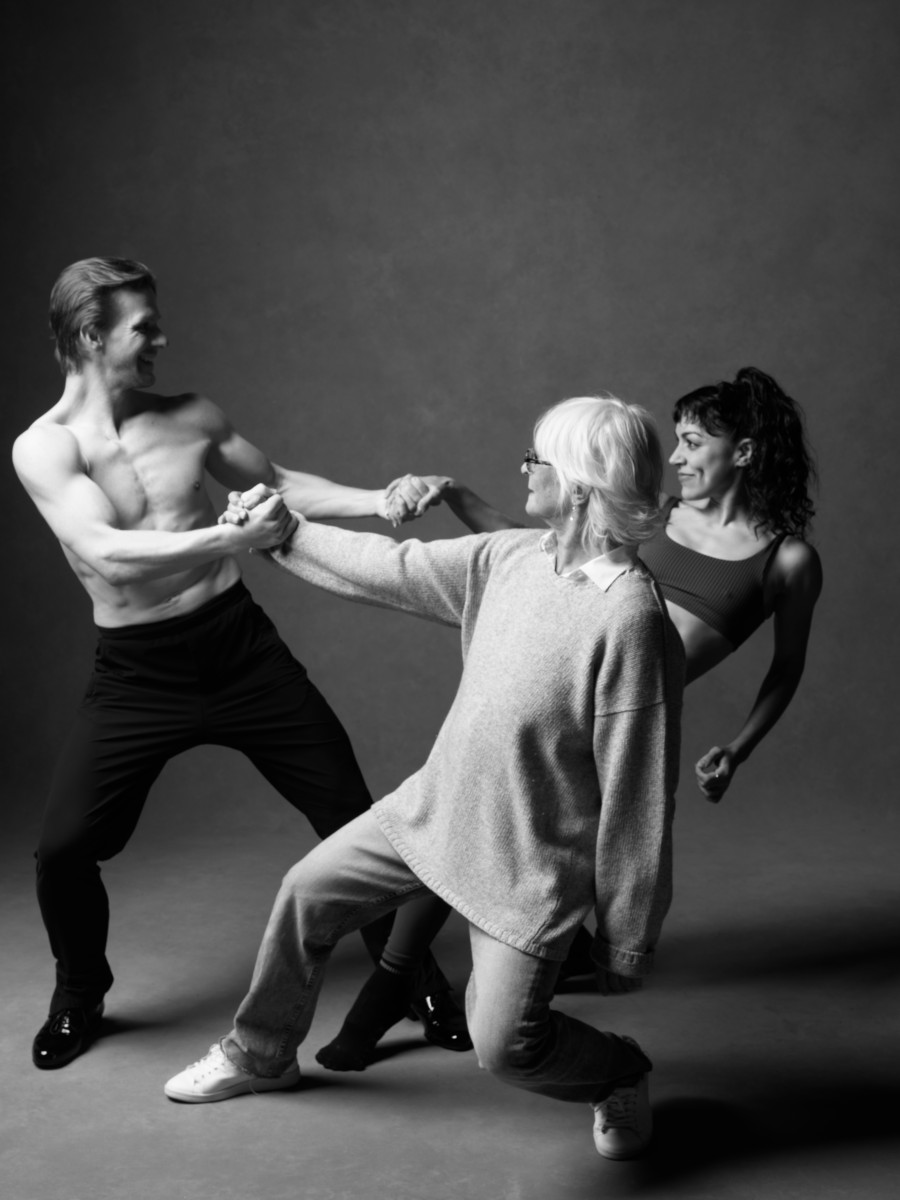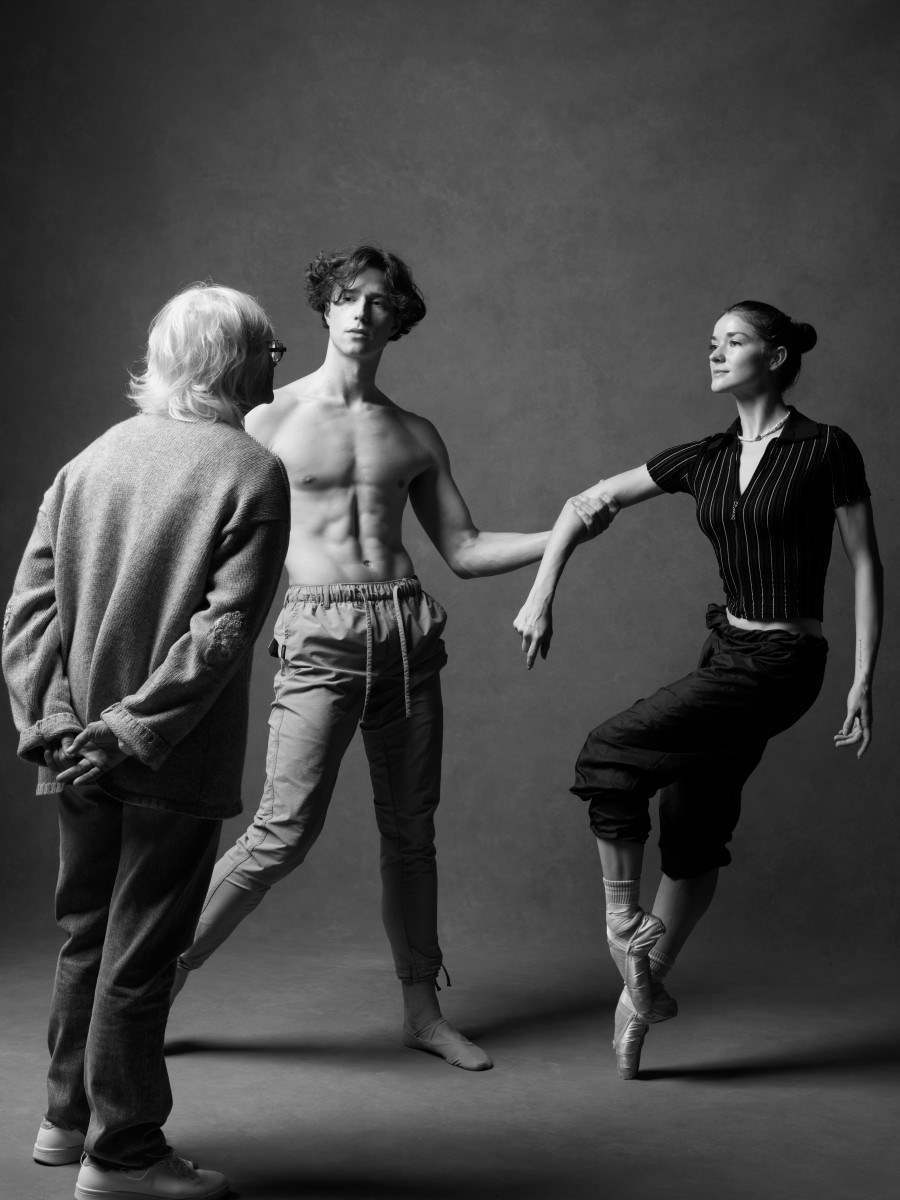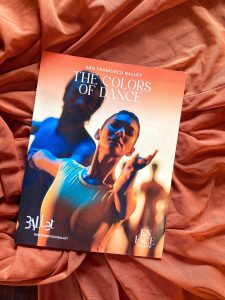
Photo by Mark Seliger.
Jeanette Delgado And Benjamin Freemantle On Performing Twyla Tharp’s Work And Working For The Legend Herself
Twyla Tharp is an icon of the American ballet community. Since beginning her choreographic journey in the 1960s, she has created over 125 ballets, choreographed for both Hollywood films and Broadway productions, authored two books, and recieved innumerable awards. New York City Center is celebrating Twyla Tharp’s work by bringing back two iconic pieces that highlight a sparkling contrast in movement styles: In the Upper Room (premiered 1986) and Nine Sinatra Songs (premiered 1982).
We had the chance to chat with Jeanette Delagdo (former Principal Dancer at Miami City Ballet) and Benjamin Freemantle(former Principal Dancer at San Francisco Ballet). These two, now freelance, dancers are incredibly talented and versatile with work the that spans many mediums, genres, and styles. Jeanette and Benjamin shared their experiences dancing these pieces and working with Twyla with us as they geared up for opening night.
Tharp’s In The Upper Room features a cast divided into two distinct groups: the stompers and the ballet people. The stompers are the group of dancers in white sneakers and the ballet people are those in more traditional ballet footwear, including bright red pointe shoes. Which group are you in and what are the unique challenges that come along with it?
Jeanette: I will be dancing the part that’s called the Bomb Squad! We’re two dancers in red pointe shoes that move together almost as one, closely side by side throughout the piece. I had the honor of dancing a stomper woman with Miami City Ballet for many years and the stamina required for that part is out of this world! As much as any part in In the Upper Room is challenging for your stamina and will power, what I find to be a unique challenge for the ballet people is the ability to release and throw your body away from its center axis (that is so much a part of Twyla’s movement) and then be able to bring yourself back to center for the more technical balletic feats required on pointe. That coupled with the fact that it’s all very speedy and the Bomb Squad has to be completely in sync throughout. It’s challenging and so worth it! She calls it a survivor piece and that is truly what you feel at the end, you’ve survived!
Benjamin: I will be out there as one of the Ballet People! As it is with both groups, stamina is definitely up there when it comes to challenges. What I would have loved about being in the other group, a stomper, is that when you get tired, you can lean into that. I think that the movement and choreography almost calls for it in a certain way. It wants to be pushed to the limits and be wild. However with the ballet people, even though you are extremely fatigued by what you’re doing in the choreography, you have to maintain the clean ballet technique and as they say about ballet, “make it look easy”. Essentially the challenge is trying to remain and continue to look like a ballet person throughout the entirety of the work.
Regardless of which group you are in, Upper Room is a nearly 40 minute marathon of extremely physical and articulate movement. How does the demanding nature of the piece inform your approach to the work?
Jeanette: Twyla had us all begin rehearsals a few months ago. We had more time than we normally would in a company to build up to these performances. This method allowed us to work slowly and with more awareness so that once we were running the piece our bodies were ready to do it. Then our minds could start believing we were capable. It also allowed us all to form friendships and bonds which helps create a sense of community. That feeling of community and camaraderie is the most powerful source in Upper Room. I think it’s the magic sauce.
Benjamin: For the sake of your life, breathe. I thought I was breathing properly as a performer – turns out I just haven’t danced in a Twyla piece before. Because the work itself is so demanding and pushes you, your natural instinct is to almost grit through it. Whereas what I’ve learned with this piece and process, and I’m sure this applies to everything, is that you have to lean into it and accept what’s happening in the moment.The second you start to get ahead of yourself with what’s about to come, your body begins to tighten and breathing becomes sporadic instead of grounded. Remaining calm is the key.

Photo by Mark Seliger.
In addition to Upper Room, the two of you are dancing another iconic Tharp piece, Nine Sinatra Songs. In what ways does Nine Sinatra Songs differ from In The Upper Room?
Jeanette: Moving into Nine Sinatra Songs after Upper Room is a complete 180. We change the focus from community to our unique, individual relationships. There is much more acting and story involved. Twyla continues to remind us of the balance between it being a dance and a scene where two humans (not dancers) are communicating. In Upper Room I’m constantly letting go of thoughts and allowing my body to respond to the music but for Sinatra, I am allowing thoughts to come and reacting to my partner with actions that have meaning.
Benjamin: I want to say in every way possible. There’s definitely the root of Twyla as an artist and a choreographer weaving through it, but it’s a whole other beast with a whole different experience for the audience. As a ballet person, my vocabulary for my body was more or less pre-determined to be within the ballet scope. But, with Sinatra Songs, I get to explore myself as a human and artist without the restraints of a “style” like “ballet” being attached to it. Never have I danced the way I get to as I do in this work. It’s a whole new way of moving and conversing with a dance partner on stage. It’s one of the rare pieces that I could honestly do over and over again because it feels like living.
Nine Sinatra Songs is danced by seven couples, each depicting a different stage of romantic relationships. Which stage do you represent and how does it feel to embody that emotion on stage?
Jeanette: I am dancing the That’s Life pas de deux with Daniel Ulbrecht. We represent a mature couple who have been together a long time but we need to argue to be able to connect and keep our passion for each other alive. It can be a challenging duet because the man can easily look like he’s overpowering the woman since most of the partnered lifts and throws are done by the man. Twyla was very adamant about changing this narrative and allowed me to use my power and strength to have a voice in the argument. It now feels like we each have equal power and we can enjoy this dynamic because ultimately we love each other. Fighting is our love language? Hehe!
Benjamin: I dance the “Baby” duet, and I represent that “should we or shouldn’t we” moment in a relationship. Neither one of us have decided if we’re willing to give up on each other or if we want to put the energy in to make it work. More than embodying the emotion, it’s about staying in that moment of time with your partner, being there to listen and to understand their needs. This is the moment that you have to pay attention to every detail and nuance to decide what it is you’re wanting and working towards. I love dancing this duet and I can’t believe I got to work with the ever-special Cassandra Trenary. Partners and relationships are everything in my world, and it’s rare to find someone who feels like home to dance with.
One fun detail about Nine Sinatra Songs is that the costumes were designed by Oscar de la Renta himself – featuring 50s dresses, tuxes, and high heels. How does this different wardrobing change how you move?
Jeanette: The high heels, oh the heels 😉 a love/hate relationship! On one hand, the heels along with the gorgeous dress help me feel more human and help me transform into this woman who is sexy and strong! However, the challenge is allowing myself to stay grounded, using my plié and softening into the tricky partnering without being able to feel the floor as I normally would on flat or in pointe shoes.
Benjamin: Walking around backstage today for the tech and seeing everyone done up in their tuxedos, dresses and wigs, it puts you in the mood. The vibe has definitely been established and all we have to do is come in and live out exactly what these clothes are saying. In my duet, I have an untied bow tie wrapped around my neck because it’s supposed to be around 3am after a party. When I put that on in front of the mirror, I feel my body language change to match the story there- so you could say it’s a part of the character.
Many times choreography is staged by repetiteurs; these are the people entrusted by a choreographer to teach a group of dancers their choreography. Twyla is staging these works. What has it been like working with the legend herself?
Jeanette: I don’t think Twyla was very happy with having to look backwards because she’s a creator and is always making and creating new works. However, she didn’t bring any of that energy into the studio. She staged the works with care, passion and heart. It has been an honor and a true privilege to learn from her and receive all of her wisdom and insight. A once in a lifetime process that we all feel extremely grateful for!
Benjamin: It’s been a wild experience, and I’m incredibly grateful and humbled that I got to have these moments with her in the studios. She is pouring with wisdom and is constantly making me reassess what I have been taught or what I know. I don’t think I have or will ever meet another human being like Twyla. To have someone like her in the front of the room everyday, giving us all that she has, pushing through like we are, and who’s truly in it for the long haul – it’s inspiring. She gives me the energy to get up and start moving.
What does it mean to you to be performing for Twyla Tharp on the legendary stage of NY City Center?
Jeanette: I had the beautiful experience of performing Upper Room for Twyla at NY City Center when Miami City Ballet toured here in 2009! I was warming up backstage doing a standing yoga pose and I felt a hand press against mine.. I turned around and there was Twyla! She said “Merde” and was gone! I have never forgotten that moment. This now feels so full circle and wild that it’s hard to put into words. Its meaning eludes me and I’m simply taking every moment in with gratitude and grace.
Benjamin: It means I’ve made it, and that I’ve arrived. To be in this group of artists, getting the opportunity of performing these ballets, on this stage, is nothing less than extraordinary. This is truly a highlight of my career, and I can’t believe that I get to be one of the lucky ones who gets to experience it. This is a moment in my life that I will not soon forget.
Twyla Tharp | In The Upper Room & Nine Sinatra Songs runs October 19th through October 23rd at the New York City Center. Tickets are available here.
![]()


Follow Us
Subscribe For Updates & Giveaways!
Stay up to date with exciting original content, upcoming performances, and giveaways unique to your community and beyond!

